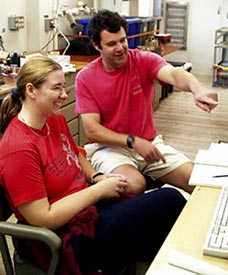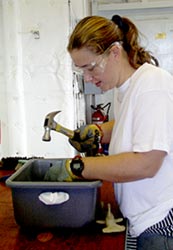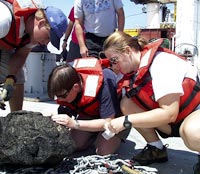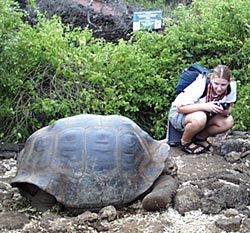|
|
Interviews: Marine Biologist Kate Buckman Tell me about the work you've been doing in Belize. Kate: I've been going to Belize for the past three summers as part of a program we hope to continue through Smith College. The first summer we surveyed the health of a coral reef. I was in charge of looking at fish populations. The second summer, I was with one other student, and we initiated a summer education program in conjunction with the Hol Chan Marine Reserve. The two of us taught children in the town of San Pedro about coral reef ecology and conservation. The third summer, I went back with four other Smith undergraduates and we advertised our program on the radio and went to schools and demonstrated some of the conservation lessons and games. That time, we had more than 20 students between 5 and 13 years old who came consistently. Each day we would start by collecting shells, pieces of dead coral and anything else we found on the beach. Then, we would put these items on each desk next to a piece of paper and some colored pencils. The students would look closely at what we had found as they were drawing it and start to feel comfortable asking questions.
What were some of the games you played? Kate: Turtle hurdles, was a favorite. It’s about the life cycle of sea turtles. But mostly it’s a huge game of tag. You start out with turtles, land predators and sea predators. Each turtle has about 100 hatchlings (beans in a plastic bag). The game begins with the baby turtles at the far end of the beach and they have to run across the beach avoiding the land predators. Then once they cross the boundary of the beach they have to continue past the sea predators until they get to the teacher standing farthest out “at sea” who is holding a life card. This represents the turtle’s first birthday. Now the turtle has to travel back toward the beach where another teacher holds another birthday card not far from “shore.” The turtles have to make it to their 10th birthday, going back and forth between the teachers, before they can go back to the land and lay their eggs. But again they have to watch out for the land predators. Every time a predator tags them they have to give up 10 hatchlings. If they run out of hatchlings before they make it back to land and lay their eggs they turn into a condo. That represents beachfront development. Luckily, that doesn’t happen often. The game demonstrates how difficult it is for turtles to survive. Question: Where else have you traveled? Kate: I went to high school at a public school in New Hampshire. My Spanish class raised money for a trip to Spain. And when I was in the Latin Club we went to Greece and Italy. The key is, if you’re interested in doing something don’t be afraid to get out and try it. The most challenging thing is finding the courage to try new experiences. The more you do it the more rewarding it is. I’ve learned there is always a way to figure out how to do something you really enjoy doing. In college I traveled to Australia for a semester studying marine biology at James Cook University in Queensland. While I was there I also took courses in silver-smithing and Australian history. We had some fabulous field trips not related to marine biology: counting bats, rodents and birds. I also spent a semester with the Sea Education Association (SEA). We spent six weeks at their campus at Woods Hole studying oceanography, nautical science and maritime studies, which combined literature and history of the sea. We developed research projects and during the next six weeks performed the experiments and studies while sailing on the SSV Corwith Cramer, one of SEA's tall ships. We sailed from Maine to Bermuda, Barbados, Guadeloupe and St. Croix. I became involved with our expedition to the Galápagos on Revelle as a result of my association with SEA.
How did you know you wanted to be a marine biologist? Kate: Kate: My first experience with the ocean was when I was swimming off the coast of Connecticut. I was terrified of the jellyfish. I made my mom and grandmother carry me out of the ocean. Now you can’t get me out of it. I grew up swimming in lakes with my older brother, Andy. I enjoyed looking at small creatures living in the lake. I think a turning point for me was reading “Shark Lady” by Eugenie Clark. Her work on sharks really inspired me. I’ve wanted to be a marine biologist since sixth grade. When I first went to college, I started working in developmental biology studying cell movement using fish embryos. That led into my study of fish populations. I really enjoy looking at fish populations so I kept doing it. I’ve been working with fish my entire undergraduate career. I became a certified SCUBA diver in 1997. I did my open water dive off the coast of Cape Cod. I love learning about the ocean. There are so many things to discover - I’ll never get bored with it. Question: What else do you do? Kate: In college, I played the French horn in an orchestra and I was captain of the Smith ice hockey team. I also love to read. I have so many favorite books it’s hard to pick which one I like the most. Probably at the top of the list I’d put the “Chronicles of Narnia,” “Cod,” a book about the history of the codfish industry in America, and Shel Silverstein’s poetry.
Do you eat seafood? Kate: It’s not that I’m morally opposed to eating seafood. I just don’t like the taste of fish. Every time I try it I don’t like it, so I’ve stopped eating it. But there are fish I won’t even try because I know they are being over-fished. Swordfish is one. |
||||||||||
Mailing List | Feedback | Glossary | For Teachers | About Us | Contact
© 2010 Dive and Discover™. Dive and Discover™ is a registered trademark of
Woods
Hole Oceanographic Institution

 Kate and Josh Curtice stand watch monitoring the MR1 sonar computer.
Kate and Josh Curtice stand watch monitoring the MR1 sonar computer.

